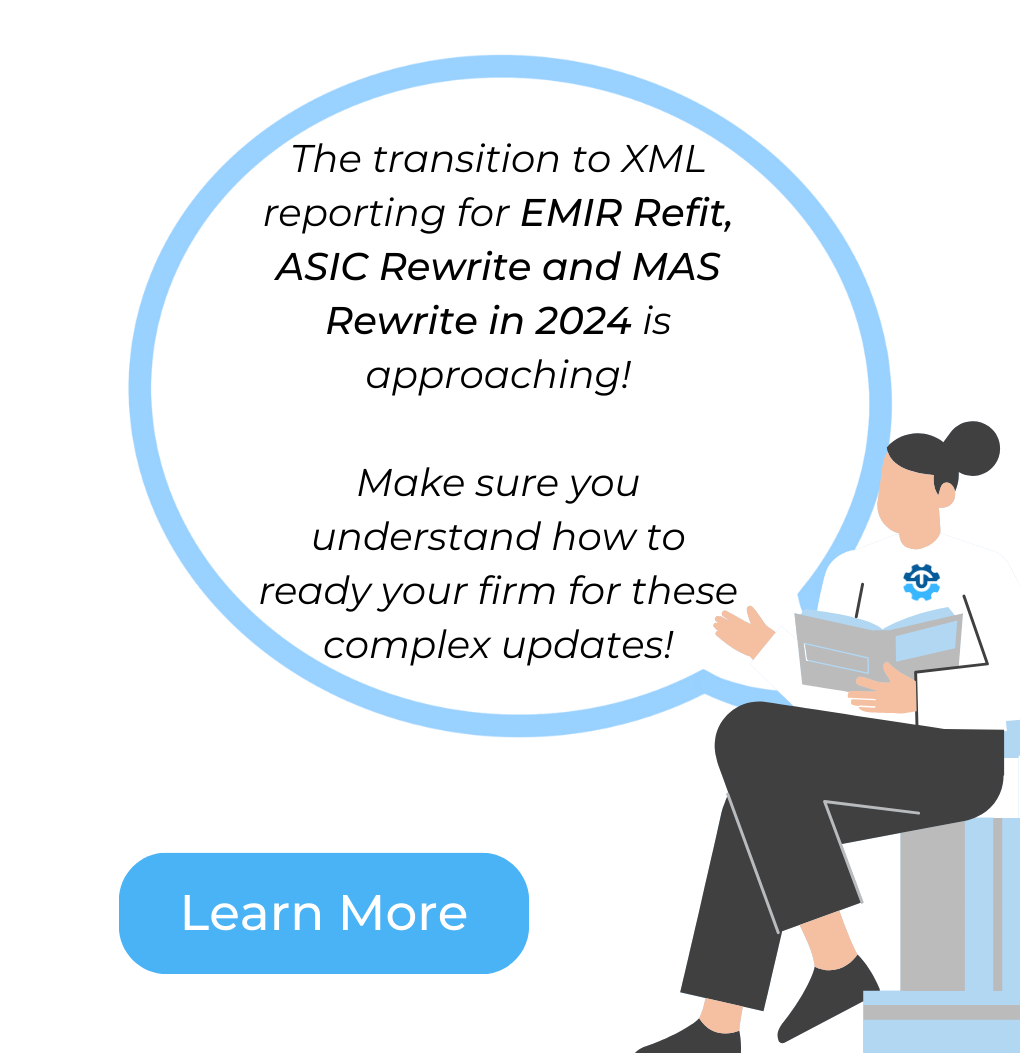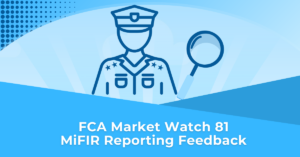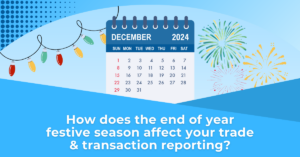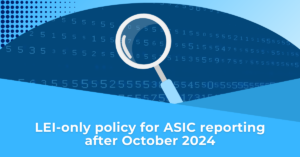After two consultation papers over more than two years, ASIC has released their final package of updated Derivatives Transaction Rules. ASIC’s reporting rules are being harmonised to global standards.
ASIC has taken industry feedback into consideration and announced there will be a consolidated release to a single update, called the ASIC Derivative Transaction Rules (Reporting) 2024 (2024 Rules) which take effect on 21 October 2024.
In the interim, the existing rules have been extended until the new regulation date and those are now known as ASIC Derivative Transaction Rules (Reporting) 2022 (2022 Rules).
What are the key changes to ASIC reporting
| Current Requirements 2022 Rules | New Requirements 2024 Rules | |
| Reporting deadline | T+1 | T+2 |
| Reporting format | N/A | XML as per ISO 20022 standard |
| Reporting style | Snapshot reporting can be used unless defined as an ‘excluded derivative’. Lifecycle method must be used for excluded derivatives. | Lifecycle reporting is required for all derivatives. |
| Delegated Reporting | Firms are permitted to delegate their reporting obligation and benefit from a safe harbour provision in the rules when doing so. | Delegation of reporting to third parties remains permissible however the safe harbour benefits have been removed, bringing the regime into line with others globally. |
| LEI requirements (non-individuals) | LEI, AVID and BIC codes are acceptable as entity identifiers. | Only an LEI is permitted as an entity identifier. A renewed LEI is only required for the reporting entity, counterparty 1 and central counterparty. |
| Data elements | 320 fields require population on DTCC’s ASIC report | 128 data elements in ASIC’s specifications Unknown number of DTCC fields at this stage. |
| Transaction-to-position conversion | N/A | Reportable transactions represented as positions which reflects a reporting entity’s books. |
| Small-scale buy-side entity exemption | N/A All firms subject to the same requirements regardless of size (with the exception of the single-sided reporting relief). | Small-scale buy-side entities such as a non-bank body regulated by APRA, non-AFS licensee and a non-exempt foreign are exempted from certain reporting requirements. |
1. Extended reporting deadline
In response to industry concerns on the complexities of UTI generation and meeting the reporting deadline, ASIC has extended the transaction reporting deadline to two business days after the trade date (T+2). In an attempt to harmonise the regulation in Asia, this extension aligns the reporting deadlines of Singapore, Hong Kong and Japan. In addition, structured transactions will have a reporting deadline of T+4.
2. Reporting under ISO 20022 standard
Reporting entities are required to submit their data to trade repositories in ISO 20022 XML message, as listed in Rule 2.2.4 of the 2024 Rules.
3. Lifecycle reporting
Since 1 July 2019, only ‘excluded derivatives’ such as CFDs, margin FX and equity derivatives have been required to use the lifecycle reporting method where intra-day changes to a transaction need to be reported. Going forward, lifecycle reporting is applied to all products, with small-scale buy-side entities exempted.
4. Removal of delegated reporting safe harbour
ASIC remains sceptical that all reporting entities are diligently ensuring their delegated reporting arrangements produce complete and accurate reporting. As such, ASIC has decided to remove ‘safe harbour’ provision and revert responsibility back on to the reporting entities. For reporting entities who typically rely on delegated reporting, the removal of safe harbour provision places a significant burden on them to ensure that their delegates are meeting the reporting requirements.
5. LEI requirement
Reporting of LEIs as entity identifiers are required for certain conditions as set out in Rule S1.3.1(2) of the 2024 Rules. In the recent Consultation Paper (CP 361), there were concerns that the requirement for a renewed and valid LEI for counterparty 2 was not harmonised. Hence in efforts to align with global standards, ASIC has advised that a renewed LEI is only required for the reporting entity, counterparty 1 and central counterparty.
6. ASIC data elements
In efforts to harmonise reporting, the 2024 Rules introduce a UTI waterfall which lists steps to determine which entity should generate the UTI. In addition, UPI is required as a reportable data element and where data elements are not embedded as reference data elements of a UPI code, ASIC has confirmed that there will be 128 data elements in total to cover these gaps. These data elements are listed in Schedule 1 of the 2024 Rules.
7. Transaction-to-position conversion
In efforts to align with ESMA methodology, ASIC has introduced position reporting. Reporting entities will need to terminate the original transaction and report the new position where the new position needs to be reported with a new UTI.
8. Small-scale buy-side entity exemption
Introduction of a small-scale buy-side entity exemption in respect of:
- reporting collateral,
- trade lifecycle changes and
- delta reporting.
This exemption of about 800 of the approximately 900 total number of reporting entities, whose aggregate notional and collateral posted is less than 2% of that of all reporting entities.
What happens to the legacy transactions
Open transactions which are executed prior to commencement of the 2024 Rules (on or before 20 October 2024) and which have the following:
- an expiration date not later than 20 October 2025; and
- a termination date on or before 20 April 2025,
will only be required to be re-reported with accurate data elements when the transaction information is recorded in electronic systems, Rule 2.4.1 of 2024 Rules.
What you need to do
You will need to review the 2024 Rules, assess the impact and changes required to your reporting processes.
Depending on the size and nature of your company, there may be significant changes which need to be made to meet the new rules.
How we can help
The changes under the 2024 Rules are significant. At TRAction, we are committed to ‘Trade Reporting Simplified’, where we will take care of all XML changes for clients, already having experience with this difficult format from other reporting regimes.
TRAction will continue to accept data from its clients and provide confirmations in csv format to facilitate the process of reviewing your reporting delegate.
Please do not hesitate to get in touch with us if you would like to know more about how we can assist with your derivatives transaction reporting.









